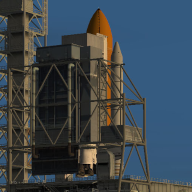This library implements a linearized Brayton cycle thermodynamic engine process model that should deliver realistic steady cruise thrust and fuel consumption for most turbojet and turbofan engines based on engine parameters that are most likely...

www.orbiter-forum.com
You'll have to modify the following section of the JetEngineLibrary.h file with the data appropriate for the variant of the CMF56 engine.
C++:
// Minimum engine parameters that must be provided for model at 100% throttle at sea level.
// Note that maximum thrust is needed to calculate specific impulse (Isp) from
// specific fuel consumption (sfc), and is used to set the maximum thrust level of the thrusters
// in Orbiter, but is not otherwise used to calculate thrust. However, the maximum
// thrust calculated by the model should be close to these input values.
// Parameters for SNECMA-M53-P2 Turbofan
const double air_mass_flow_max = 92.0; //maximum air flow rate through engine [kg/s]
const double inlet_diameter = 0.796; //inlet diameter of engine (fan diameter if turbofan) [m]
const double max_thrust = 65.0; //maximum thrust without afterburner [kN]
const double rp_max = 9.8; //compressor pressure ratio at full throttle [-]
const double sfc = 32.4; //specific fuel consumption at full throttle [g/kN s]
const double bpr = 0.36; //turbofan bypass ratio (mass flow through fan / mass flow through core, 0 for pure turbojets)
const double fpr = 2.0; //turbofan pressure ratio (0 for pure turbojets)
const double max_thrust_ab = 95.0; //maximum thrust with afterburner [kN]
const double sfc_ab = 53.0; //specific fuel consumption with afterburner [g/kN s]
You can find most of these parameters for the CFM56 variants here:

en.wikipedia.org
As there is no afterburner you can set max_thrust_ab and sfc_ab = 0. The turbofan pressure ratio can be hard to find, but it's typically around 1.5 - 2.
This jet engine model works very well for turbojets and low-bypass turbofans, but it tends to overestimate thrust for high-bypass turbofans like the CFM56. In high-bypass turbofans the thrust produced by the core jet is relatively small compared to the thrust of the fan. These engines behave more like ducted turboprops than turbojets.
If the calculated thrust is too high, you can try just scaling the thrust calculated by the model to match the specified thrust at full throttle. That should give you pretty good numbers and correct air-breathing behavior.












